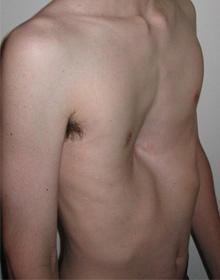One of two surgeries has traditionally been used to treat a fairly common congential deformity called pectus excavatum—until this year. A pediatric surgeon at the University of California, San Francisco’s Benioff Children’s Hospital has developed an alternative using magnets and an external brace.
Pectus excavaturm is a malformation of the chest wall in which several ribs and the sternum grow abnormally, resulting in a caved-in, or sunken appearance. It occurs more often in boys than in girls. Although its causes are not completely understood, the condition is believed to arise from excessive growth of the cartilage connecting the ribs to the breastbone, which pulls the sternum inward.
 Now Dr. Michael Harrison is implanting a powerful magnet in a handful of young teen patients. The magnet, which is right beneath the skin, is pulled toward a second magnet attached to a brace the patients wear at all times for two years. The idea is that slowly the chest wall will be pulled outward—painlessly. Since the method is in its early trial phase, no results have appeared yet.
Now Dr. Michael Harrison is implanting a powerful magnet in a handful of young teen patients. The magnet, which is right beneath the skin, is pulled toward a second magnet attached to a brace the patients wear at all times for two years. The idea is that slowly the chest wall will be pulled outward—painlessly. Since the method is in its early trial phase, no results have appeared yet.
“Although we are not part of this trial,” says Lyall Gorenstein, MD, General Thoracic Surgery, NewYork-Presbyterian Hospital/Columbia University Medical Center, “it’s a very interesting concept. We look forward to seeing how the study turns out.”
Until then, read about the surgical treatment options for pectus excavatum Dr. Gorenstein performs on pectus excavatum patients at NYP/Columbia.
